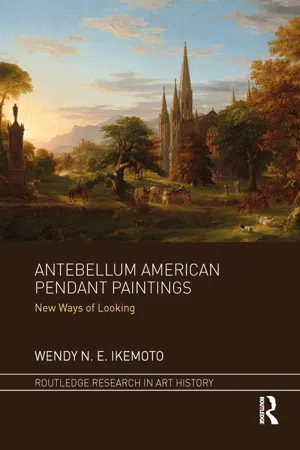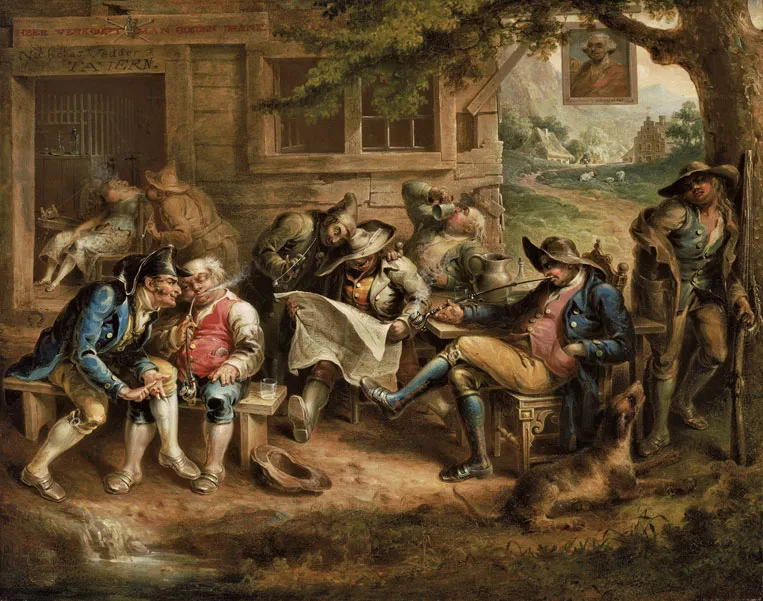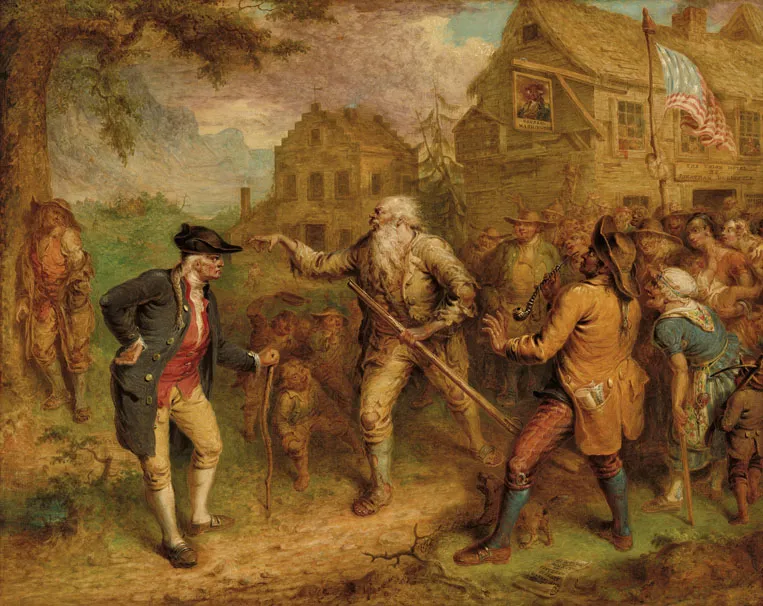![]()
1Putting the “Rip” in Rip Van Winkle
Historical Absence in John Quidor’s Pendant Paintings
Unfolding in the “phlegm and drowsy tranquility” of pre-Revolutionary America and concluding in the “busy, bustling, disputatious” hubbub of independence, the story “Rip Van Winkle” tails its henpecked protagonist from his village into the dark recesses of the Catskill Mountains. There he encounters a mysterious group of characters playing at ninepins and, upon imbibing from their flagons, falls into a deep slumber. Awakening twenty years later, Rip returns to town only to be confronted by drastic transformation: the American Revolution has rendered his village an enigma and Rip himself a bewildered victim of time.1
Originally published in 1819, “Rip Van Winkle” concluded the first of seven installments of Washington Irving’s pseudonymously published The Sketch Book of Geoffrey Crayon, Gent. It met with immediate success. Irving’s business manager reported that “demand [for the book] rises in every quarter.” Contemporary reviewers praised “Rip Van Winkle” as an “exquisite and classical [piece] of writing” and described it as “ingeniously contrived … with a free, spirited touch.” The name “Rip Van Winkle” entered the national lexicon. In 1820, for example, the Plough Boy reported on the reappearance of one Mr. Dunham after a twenty-nine-year absence: “He was like Rip Van Winkle, unknown in the place of his youthful residence.” A writer for the Spirit of the Times used the name in the following decades to designate one “considerably behind the age.” Still another used it in a call to action for the United States naval forces: “It is time for Rip Van Winkle to be awake!” The popularity of Irving’s narrative also spawned a variety of adaptations. These included book illustrations by Felix O. Darley, Richard Westall, and Henry Sandham; paintings by Charles Bird King and Asher B. Durand; a sculpture by John Rogers; a play starring Joseph Jefferson along with photographs by Napoleon Sarony featuring Jefferson in the title role; and even a Rip Van Winkle operetta by Robert Planquette. From sales to reportage, engraving, and theater, Irving’s story pervaded the cultural scene.2
This chapter focuses on a pendant of Rip Van Winkle paintings by John Quidor (1801–81). Painted in 1839 and 1849, respectively, Rip Van Winkle and His Companions at the Inn Door of Nicholas Vedder (Plate 1) and The Return of Rip Van Winkle (Plate 2) depict the before and after of Rip’s mysterious sleep. The first pictures the protagonist in his colonial village, and the second illustrates his return to a postwar town. Quidor renders the two scenes from the story in strikingly similar formal terms. Both paintings set a group of villagers against an architectural backdrop that opens onto a lush vista with distant mountains. Both include a signpost featuring the likeness of a political ruler (King George in the first scene, and General Washington in the second). Both arrange the figures in a rough W that spreads from one edge of the canvas to the other. The facial profile, black hat, and aggressive posture of the man on the left of the Return echo those of the man on the left of the Companions. The facial profile, wide-brimmed brown hat, and backward-leaning pose of the man on the right side of each painting likewise match. A hatless, balding head marks the rough center of each image. And the position of young Rip under the tree on the far right of the first composition mirrors that of his grown son under a similar tree on the far left of the second. The paintings’ combined narrative and compositional congruence make it difficult not to consider them related. Even so, they have never been studied as such.3 The Companions has received scant scholarly attention, and the Return has been treated as an independent work.
Analyses of the Return have focused on Rip as a figure of dislocation who sleeps through history and wakes to a changed world. He appears in Quidor’s composition as a figure displaced: confused, anachronistic, and alienated both physically and psychologically from a hostile post-Revolutionary crowd.4 Such readings take historical change as a given. Rip is characterized as disoriented – indeed, victimized – by the transformations that occurred during his twenty-year nap. Consideration of the Return as one of a pendant crucially undermines this progressive premise. As a set, Companions and Return form a structure of retrospection concerned with the very efficacy of the past.
This chapter focuses on the before-and-after structure of Quidor’s Revolutionary narrative and particularly on the elision between the two canvases: the pendant pictures colonial and independent communities, but not the Revolution itself. Quidor’s oblique treatment of the nation’s origins is compared with contemporary history painting and also with his own work as a painter for New York City’s firefighting companies. The former exposes the idiosyncrasy of Quidor’s approach to history, and the latter links his preoccupation with the past to a milieu of material loss. The interval between the two Rip Van Winkle canvases emerges as the key player in a satirical critique of history. By framing the nation’s founding in before-and-after scenes, Quidor turns a story of history making into a retrospective look at the very lack of a transformative past.
An Idiosyncratic Artist
More than two-thirds of Quidor’s extant paintings depict scenes from Irving’s writings, including The Sketch Book, Knickerbocker’s History of New York (1809), and Tales of a Traveller (1824). Though the author’s literary subjects were wide-ranging (The Sketch Book itself was written in England, and only five of the twenty-nine stories in the first American edition were devoted to American subjects), Quidor drew exclusively upon Irving’s tales of old New York. The choice demonstrates the painter’s keen interest in America’s regional past, both on its own terms and as the site for national narratives, such as American independence, that were telescoped onto it. This interest was likely enhanced by the fact that the painter was born and lived until age 9 in the Hudson River valley, the site of many of Irving’s American stories, including “Rip Van Winkle.”5
Despite his affinity for the writer’s American tales, Quidor depicted them in a highly idiosyncratic manner. Scholars have characterized the relationship between the two men’s work as a process of open adaptation. Though clearly inspired by Irving’s narratives, Quidor’s paintings have been described as brasher and moodier, and more audacious, chaotic, and psychologically intense than their sources. Reasons given for this departure have been diverse. Quidor was an artist of the working class while Irving lived the life of a gentleman. As such, the painter was less bound to rules of decorum. Quidor was nearly twenty years Irving’s junior. As a result, he grew up in a different generation – in the midst of gothic culture – and shared his period’s interest in plumbing darker depths.6 What is clear is that even when describing scenes from Irving’s stories, the painter reworked the material in his own terms. As will become clear, in the case of the Rip Van Winkle paintings he willfully heightened key ambiguities lurking in the textual source.
Except for a brief period (ca. 1837–50) when he was involved in farming and land speculation in Illinois, Quidor spent his adult life in New York City. He took a studio in the heart of the infamous Five Points district and divided his time between painting panels for New York City’s fire engine companies and producing his predominantly literary easel paintings for exhibition at the National Academy of Design, American Academy of Fine Arts, and Pennsylvania Academy of the Fine Arts. The characteristic style of his easel paintings, which reached maturity in the 1830s, featured knotted trees, distorted figures, strong modeling, dramatic chiaroscuro, brilliant color, thick swabs of paint (sometimes in the form of pure pigment), interlocking forms, and lively compositions. During a period dominated by the classical arrangement, clear and even light, and verisimilar style of, for example, William Sidney Mount and George Caleb Bingham, Quidor was developing an idiosyncratic style based largely on baroque design and traditions of caricature by artists such as William Hogarth and James Gillray.7
His hyperbolic paintings received mixed reviews. A Battle Scene from Knickerbocker’s History of New York (1838), for example, was disparaged as a “sad medley of broken shins and bloody noses.” Ichabod Crane Pursued by the Headless Horseman (1828) was mocked for picturing a horse “unlike anything in the heavens above, the Earth beneath, or the waters under the Earth,” and Leatherstocking Meets the Law (1832) for clouds that looked like “Flying apple dumplings.” The thwarted panther attack in Leatherstocking’s Rescue (1832) was commended, however, for its “highly meritorious” depiction of the “agonies of the dying beast,” and the figure of Mud Sam “scrambling out of the hole” in The Money Diggers (1832) deemed “extremely well done.”8
Quidor stopped painting in this characteristic style about the time he left New York. Records indicate that the artist was in Illinois by 1837, and the close of his early period is generally dated to 1839. Although Quidor continued to paint throughout his sojourn in Illinois and when he returned to New York, his work of the 1850s and 1860s lacks the bravura that defined his earlier pictures. In place of vibrant palettes and sculpturesque modeling appear hazy forms, agitated lines, diffuse lighting, and diluted color. A comparison of Quidor’s...


